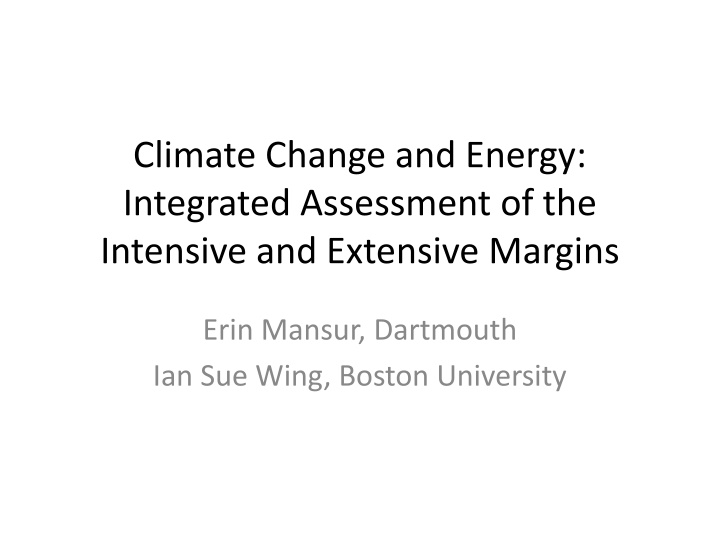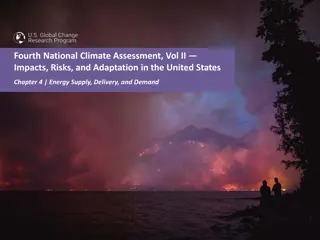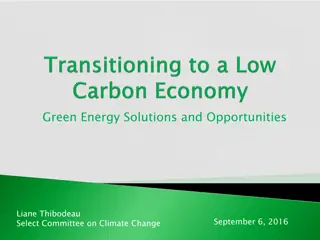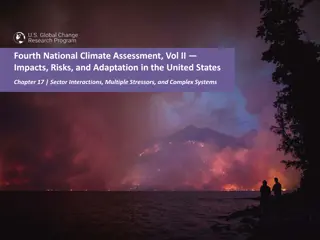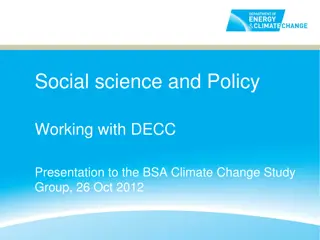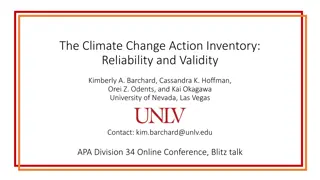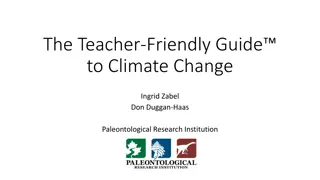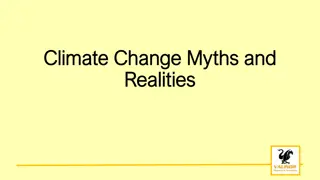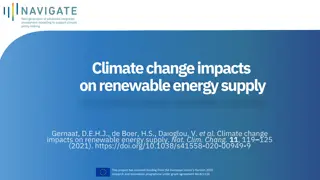Climate Change and Energy: Integrated Assessment
This study explores the impact of temperature change on energy demand, adaptation through the adoption of air conditioners, runoff change on hydro-power supply, and the economic effects of climate-induced changes in electricity demand. It delves into the intensive and extensive margins of energy demand and consumption behavior in response to climate change, emphasizing the importance of understanding technology adoption and short-term weather responses. Various methods to measure energy expenditures and climate data are discussed, along with the significance of cross-sectional analysis in identifying household response to climate variations.
Download Presentation

Please find below an Image/Link to download the presentation.
The content on the website is provided AS IS for your information and personal use only. It may not be sold, licensed, or shared on other websites without obtaining consent from the author.If you encounter any issues during the download, it is possible that the publisher has removed the file from their server.
You are allowed to download the files provided on this website for personal or commercial use, subject to the condition that they are used lawfully. All files are the property of their respective owners.
The content on the website is provided AS IS for your information and personal use only. It may not be sold, licensed, or shared on other websites without obtaining consent from the author.
E N D
Presentation Transcript
Climate Change and Energy: Integrated Assessment of the Intensive and Extensive Margins Erin Mansur, Dartmouth Ian Sue Wing, Boston University
Climate Impacts on Energy: A Roadmap Empirical Modeling Demand Supply Demand Supply Intensive Margin Intensive Margin Extensive Margin Intensive Margin Extensive Margin Extensive Margin Intensive Margin Extensive Margin (1) (2) (3) (4) What is the impact of temperature change on the demand for energy (electricity)? What is the impact of temperature change on adaptation via adoption of air conditioners? What is the impact of runoff change on hydro- power supply? What is the economic effect of climate- induced changes in electricity demand?
The Demand Side Intensive Margin (Lots of work, past and present)
Energy Demand & Climate Change Consumers may respond to climate change either along the intensive or extensive margin Understanding technology adoption (i.e., the extensive margin) is key in modeling adaptive behavior The short run response to weather (the intensive margin) also matters Even here, the technology available affects how elastic will be demand response
Potential Methods to Measure Energy Expenditures and Climate Ideal data Info on how a household consumes energy in multiple climates But technology, demographics, prices, and preferences change faster than the climate Methods 1. Cross-sectional Climate Data 2. Time series and Panel Data on Weather
Cross Section Variation in climate can be informative of both the intensive and extensive margins Multiple households with similar observable characteristics but located in different climates Vaage (2000); Mansur et al. (2008) Main concern is omitted variable bias Unobservable household characteristics correlated with climate Albouy et al. (2012) and northern households to be less heat-tolerant than southern household
Cross Sectional Literature Vaage (2000) Discrete-continuous choice modeling in Norway Choice of heating (wood/oil/electricity) Control for household characteristics and fuel prices Indicator of relative climate Warmer households are less likely to choose all fuels, and spend 30 percent less on fuel Mansur, Mendelsohn, and Morrison (2008) Discrete-continuous choice modeling in US Indentify fuel selection using prices of all fuel options Energy expenditures increase with climate change Warmer climate results in more homes heat with electricity Warmer summers result in more electricity consumption Warmer winters will result in less natural gas consumption $57 Billion annually for a 5 C increase
Issues with Cross Section Approach Unobservable differences may be correlated with climate Sorting (e.g., households with lower disutility for extreme heat sort into warmer climates) Estimates of sensitivity to temperatures are biased towards zero if households do not always maintain a constant interior temperature Ignores cost of transition Long run equilibrium inference To be indicative of long run, requires that variables (like weather and prices) in the sample year equal their respective expected distributions for each market or geographic region
Intensive Margin: Weather Data Examine how energy consumption responds to weather shocks Reduced-form, short run response E.g, Desch nes and Greenstone (2011) and Auffhammer and Aroonruengsawat (2011) Estimates may overstate the damages from climate change Households adapt to a gradually changing environment in ways they could not in short run
Deschnes and Greenstone (2011) Explain variation in state-level annual panel data of residential energy consumption using flexible functional forms of daily mean temperatures Data EIA State Energy Data System (Annual BTUs) National Climatic Data Center (Ave daily temp) Control for precipitation, income & population
Deschnes and Greenstone (2011), Figure 3 The Estimated Relative Impact of a Single Day in a given mean temperature ( F) bin (Relative to a Day in the 50-60 F Bin) on Log Annual Residential Energy Consumption.
Auffhammer and Aroonruengsawat (2011) California household-level electricity billing data Model similar to D&G Include precipitation and retail electricity price controls
Extensive Margin: Air Conditioning Biddle (2008) From 1955 to 1980, AC penetration in the US went from 2% to 50% Cross sectional study of 1960, 1970 and 1980 censuses Standard Metropolitan Statistical Area Data Control for income, CDD, HDD, wind speed, relative humidity, electricity prices, other home characteristics Also looks at household level data to better understand role of demographics (SMSA F.E. so no climate variation)
The Demand Side Extensive Margin (A world of possibilities)
Penetration of Air Conditioners Table of Percentage of Occupied Housing Units with Some AC Census Division New England Mid-Atlantic East North Central West North Central South Atlantic East South Central West South Central Mountain Pacific US Total 1960 4.9 11.5 8.7 15.2 13.2 15.6 27.2 11.2 8.3 12.6 1970 17.8 33.2 29.6 41.3 45.2 45.7 60.6 29.7 21.1 35.8 1980 34.3 45.8 50.1 64.8 76.1 66.5 81.7 47.6 33.8 58.5 Source: Census of Housing, 1960, 1970, and 1980.
Technology Adoption as Climate Adaptation: Evidence from US Air Conditioning Penetration Would like to identify for policy makers and integrated assessment modelers a reduced-form, long run response coefficient In learning about the extensive margin, its important to keep in mind that capital investments are being made in the context of a continuously changing and uncertain climate How we would adapt in a stable system might look very different We seek to develop a response surface that captures both the intensive and the extensive margins which could be incorporated into IAMs
Preliminary work using Census For each census tract, we know the share of households that have central AC, or any AC, in 1970 and 1980. Match with county weather data of previous decade (GLDAS 3-hour temperature and humidity forcings) Regress AC share on flexible function of climate variables, controlling for tract demographics
The Supply Side Intensive Margin (Just getting going)
Climate Change Impacts on U.S. Hydroelectric Supply h = hydrological units (watersheds) i = hydro units (950) t = time (months, 1970-2012) j = bins of temperature (GLDAS) k = bins of total runoff (GLDAS) ??,? ??,?,? ??,?,? = hydro generation ,? = counts of 3-hour blocks in temperature bin j, dam i, month t ,? = counts of 3-hour blocks in runoff bin k, dam i, month t Empirical model: linear panel data with unit fixed effects ,???,?,? ,?+ ,???,?,? ,?+ ??,? = ??,? + ?? + log??,? ?? ?? ? ? Apply GCM runs to fitted regression eqn. to compute shocks to generation.
Generation Impacts of Changes in Runoff and Temperature
Modeling (We can do this. Just give us the shocks!)
Modeling Impacts: A Production Function Approach IP: Intermediate input productivity shock (> 1) IS: Intermediate input supply shock (<1) LS: Labor supply shock (<1) RP: Resource productivity shock (>1) LP: Labor productivity shock (>1) RS: Resource supply shock (<1) ??= ?? ? ????,????,??1??1, ,??????,??1??1, ,?????? KS: Capital supply shock (>1) YP: Output KP: Capital productivity shock (>1) productivity shock (< 1) ?? = output, ?? = labor input, ?? = capital input, ??? = type-? intermediate input (? = 1, ,? ), ??? = type-? resource input (? = 1, ,? ) ?? = total factor productivity, ?? = labor productivity, ?? = capital productivity, ??? = intermediate input productivity, ??? = resource productivity 28
The Intensive Margin (Easy) Climate induced increases in electricity demand Biased technological retrogression in an intermediate input to producers cost functions and consumers expenditure functions Climate induced reductions in hydropower supply Decline in endowment of fixed factor input to technology-specific cost function
The Extensive Margin (Hard) Demand side No residential capital in a social accounting matrix! AC has to be introduced via either capital goods industry or some private households dummy sector Supply side We need to understand the impact of climate on energy production capacity additions More econometric work necessary to understand the effects of weather shocks as a component on demand on the propensity to construct new electric power units
Summary (Much to be done)
Climate Impacts on Energy: A Roadmap Empirical Modeling Demand Supply Demand Supply Intensive Margin Intensive Margin Extensive Margin Intensive Margin Extensive Margin Extensive Margin Intensive Margin Extensive Margin (1) (2) (3) (4) What is the impact of temperature change on the demand for energy (electricity)? What is the impact of temperature change on adaptation via adoption of air conditioners? What is the impact of runoff change on hydro- power supply? What is the economic effect of climate- induced changes in electricity demand?
